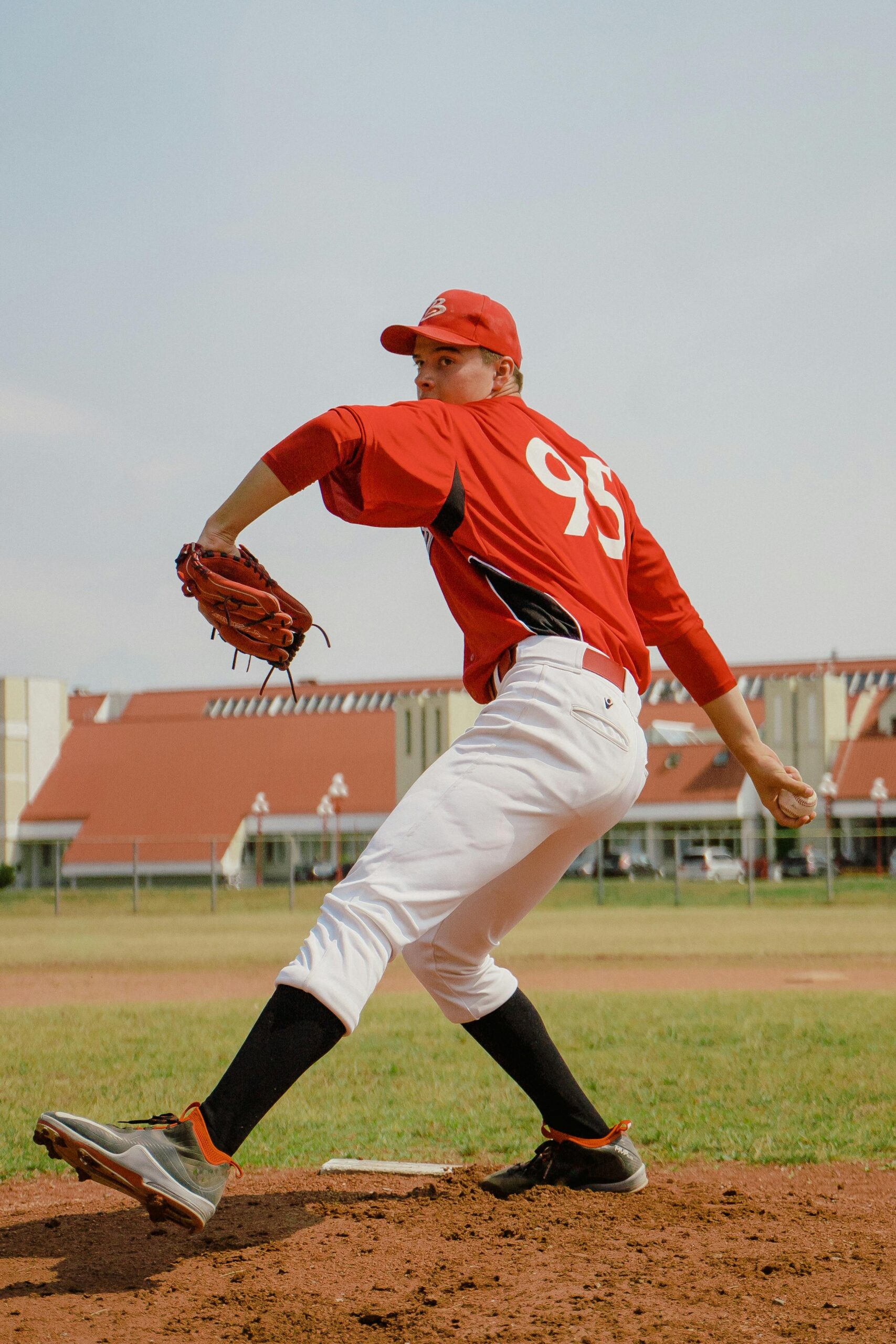
Baseball Pitching: What Causes a Baseball Pitcher to Throw Hard?
By Dr. John Mishock, PT, DPT, DC
In baseball, it is often said that the pitcher has a strong arm. However, this phrase is a misnomer. Research clearly shows that the arm musculature (hand, forearm, and arm) contributes only about 20-25% of throwing velocity. (Gretchen et al. J Strength Cond, 2010; Neil et al. J Exp Bio, 2014) The arm is accelerated through the throwing zone much like a whip. In snapping a whip, the energy is created by the users’ forceful downward movement, causing the energy to be transferred through the shoulder/arm to the whip’s end. The whips end does not create the force or endpoint energy, it is the forceful rapid arm movement. The end of the whip is much like the throwing arm. The throwing arm directs the force, however, it does not create the force.
In throwing hard, what muscles groups create the force to “whip” the arm throw the throwing zone?
1. Triple extensors of the ankle, knee, and hip: (gastroc-soleus, hamstring, and gluteus maximus muscle): These muscles exert explosive power during the linear phase (push off the rubber) of throwing. The loading of the backside and push-off creates the first opportunity for power.
2. Hips and Core: (gluteus medius, tensor fasciae latae, sartorus, piriformis, internal/external obliques, transversus abdominius, rectus abdominius muscles): Following the push-off, the energy is transferred up the kinetic chain to the rotational muscles of the hips and torso.
3. Chest and back muscles: (pectoralis major and latissimus dorsi) muscles. Following the contraction of the hips and torso, the energy is transferred to the chest and back representing the final significant muscle component to throwing hard.
Bottom line, the lower half and core create most of the linear and rotational kinetic energy to throw hard.
In throwing hard, does the type of muscle (fast-twitch or slow-twitch) affect pitching velocity?
There are two types of muscle, fast and slow twitch. Fast-twitch is utilized for explosive activities such as sprinting, jumping, and throwing hard. The great the amount of fast-twitch muscle in the key throwing muscles the greater the capacity to throw hard. Much of the muscle type is based on God-given genetics, however, exercise training may allow a small percentage of muscle fiber to differentiate into fast-twitch fibers. In most cases to have elite level throwing velocity, fast-twitch muscle is an essential component.
In throwing hard, why are pitching mechanics important?
Sound pitching mechanics allows the pitcher to throw harder by creating elastic or kinetic energy through the stacking of forces. Elastic energy develops when a muscle is put on stretch and then quickly released. Much like pulling a rubber band, putting it on stretch, and then releasing it. In the body, energy is created when soft tissues are (muscles, tendons, and fascia) are put on stretch (eccentric muscle contraction) and then quickly released. This elastic energy is added to the muscle contraction force(concentric muscle contraction) thus enhancing power. In order, to have this stacking and release of energy a stable base must first be created proximally or below the body segment to be moved. A basic tenet of human movement is that stiffness or stability of one body part enhances mobility and movement distal to that body segment, aka proximal stability for distal mobility. Scientifically based pitching mechanics allow for the proper transfer and sequencing of energy up the kinetic chain.
In throwing harder, where is elastic energy created during proper pitch mechanics?
1. The wind-up: During the wind up the torso and hips are put on stretch by rotating back into a closed position. Much like a snake coiling before striking.
2. Front foot landing: When the front hits the ground the knee extends creating a stable base catapulting the hip over the front side. During this phase, the hips are put on stretch and then released during rotation.
3. Shoulder-hip separation: The hips then become the stable base as energy is transferred to the rotationally stretched torso/core. The torso/core contracts propelling energy to the shoulder.
4. Late cocking phase of the shoulder: The torso/core becomes the stable base as the shoulder is put on stretch (late cocking phase of pitching). The energy is then passed to the arm and the shoulder becomes the stable base.
5. Wrist cocking: The wrist is put on stretch and then released upon contraction.
Proper throwing mechanics allows the stacking, unwinding, and release of the elastic energy implemented on the baseball allowing the pitcher to throw harder. These throwing mechanics can significantly improve throwing velocity by as much as 20-30%. (Matsuo et al. J Biomech, 2001, Ramsey et al. Hum Mov Sci, 2014)
In throwing harder, what are the key components?
1. Scientifically based periodization exercise training: Proper training of the muscles that create linear and rotational power is critical for throwing harder.
2. Scientifically based pitching mechanics: Strong pitch mechanics can create the elastic energy to throw hard.
Combining Proper exercise training and throwing mechanics will allow the pitcher to throw harder with greater control. It also reduces arm injury potential by reducing strain on the elbow and shoulder related to poor mechanics and inadequate baseball physical fitness. My book “Fundamental Training Principles: Essential Knowledge for Building the Elite Athlete”, “The Rubber Arm; Using Science to Increase Pitch Control, Improve Velocity, and Prevent Elbow and Shoulder Injury”
We can help!
Visit our website to read more http://www.mishockpt.comphysical therapy related articles, learn more about our treatment philosophy, our physical therapy staff, and our 5 convenient locations in Gilbertsville*, Skippack, Boyertown, Phoenixville*, Limerick* at www.mishockpt.com.
Dr. Mishock is one of only a few clinicians with doctorate-level degrees in both physical therapy and chiropractic in the state of Pennsylvania. He has also authored two books; “Fundamental Training Principles: Essential Knowledge for Building the Elite Athlete”, “The Rubber Arm; Using Science to Increase Pitch Control, Improve Velocity, and Prevent Elbow and Shoulder Injury” both can be bought on http://www.amazon.com or http://train2playsports.com.
